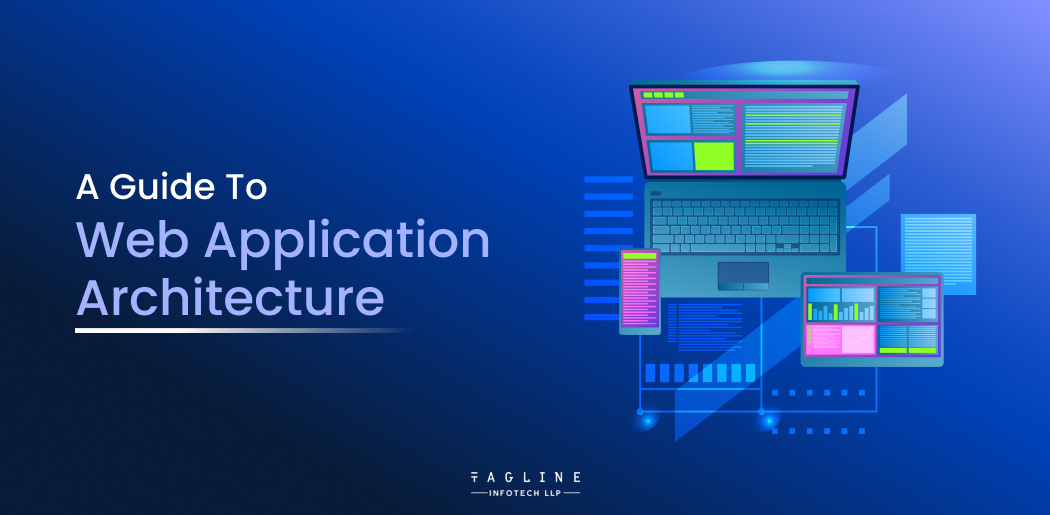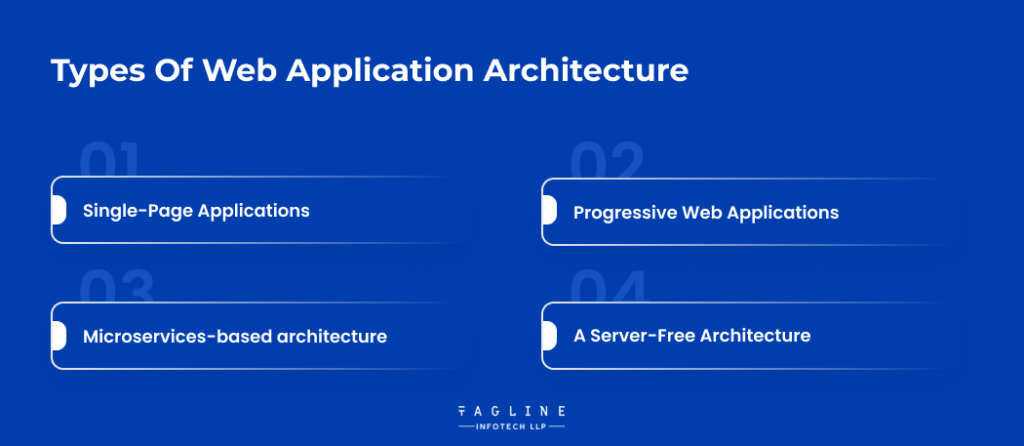The best AI-enabled hospital management system for your...
May 2, 2024
Home >> Web Development >> A Guide To Web Application Architecture

Quick Summary
The design of the architecture is a crucial first step in the process of creating web applications. It determines the structure and operation of your web application. Everything there is to know about web application architecture, including its types, models, semantics, and more, may be found in the most recent compilation of material. Following this extensive lesson, You will thoroughly understand web application architecture.
In recent years, corporations have been using web apps more and more frequently. Users can access them through the Internet, where they offer interactive features. On the other hand, the first step in creating a web application is selecting the best architecture. The architecture of your web application will determine the quality of your online application.
The architecture functions as a blueprint that describes the different parts and the data flow between them to solve a business problem. If you carefully study the architecture of your web application, it will be more secure, adaptable, and scalable, which will work to your long-term benefit. This is a crucial phase when it comes to services for building web applications. On the other hand, you must be conscious of the decisions you make when creating your online application.
Think about this: can your web application be modified to match your needs in the future if it is built without a proper architectural design? You will find it challenging to change your web application for several reasons, including its rigidly defined structure, complexity, and lack of flexibility.
You will need to make considerable changes if the framework around which your web application was built needs to support straightforward updates or the addition of new features. This means extra costs will be associated with developing your web application. Given this, there are a lot of solid arguments that show why online applications need robust architectures.
A web application architecture diagram usually consists of the following three main elements:
The browser, sometimes referred to as the client-side or front-end component, is the most crucial part since it controls how the user interacts with the program and is the one that communicates with the user, takes input, and manages display logic. In addition, user inputs are checked when required.
The web server, the server-side or backend component, is responsible for processing the business logic and running the software. In addition, it handles user queries by guiding them to the relevant section and offering overall application administration. It can take and respond to a variety of client requests.
The database server, the third element, gives the program the data it needs. It handles tasks related to data. Database servers may efficiently manage business logic in a multi-tiered design using stored procedures.
“Top 8 Backend Frameworks for Web Development in 2023 “
– Also Read Article
Nowadays, most modern web application designs are built using several layers that follow the separation of concerns methodology. The typical three-tier web application architecture comprises the user interface (UI), business logic, and data access layer. Let’s examine these layers more closely:
The user interface, or UI, layer in web application architecture. This layer handles the client-side interactions. The presentation layer, also in charge of gathering user input during the process, acts as an interface between the user interface and the web browser. Its construction uses front-end development frameworks, including HTML, CSS, and JavaScript. This layer interacts with the application layer to receive the data rendered on the user displays.
This layer is the equivalent of a web application’s engine, which takes in data, processes it, and creates output before sending it to the display layer. The application layer goes by a few other names, such as the Business Logic Layer and the Domain Logic Layer. It is in charge of overseeing the basic logic of web applications. This layer interacts with the data access and client (presentation) layers. The data access layer provides the layer that processes user inputs with data, which this layer then processes.
This layer—the persistence layer—enables communication between the database and the application layer. This layer handles all calls for data transactions and grants access to permanent data. Database management system software facilitates data retrieval and parsing, enabling connectivity with applications, database infrastructure, and user interfaces. The data must be retrieved from the data access layer by the application layer, which is also in charge of processing it before presenting it in another way. Furthermore, it encompasses integrations with external services like payment gateways.
These are the primary layers of web application architecture; additional layers may exist depending on how complicated the online program is. Because these three layers form the core of client-server interaction, they are universal across most online applications.
Ready to Elevate Your Web Development Projects?
Hire a skilled developer and transform your web applications into powerful, efficient, and scalable assets!

The architecture type of a web application is the pattern that controls how its constituent parts communicate. A client-side architecture, a server-side architecture, and a hosting paradigm could be used to categorize the underlying layers.
The architecture of this web application is to show only content relevant to the user’s needs. It loads the required webpage first and then dynamically modifies its content representation using only the requested data.
Or, it just sends requests for the necessary webpage components and loads new pages without consulting the server.
Applications that are only one page improve user experience by making things run more smoothly and seem more natural.
Because of their unique structure, progressive web apps remain one of the most exciting developments in the online application space. They give a simple user experience that can be accessed from any browser or device using a shared URL, which is both practical and efficient.
Several industries can benefit from progressive web apps like online retail, finance, and entertainment. These apps’ primary benefits are that they are affordable, lightweight, cross-platform compatible, capable of driving traffic online, and offer a fully functional app experience.
Microservices are often used to replace web applications’ unreliable monolithic design. To be more precise, they share the functionality to provide modest and lightweight services in an alternative way.
Specifically, they are loosely coupled and communicate via application programming interfaces (APIs) if a complicated business issue arises. This feature significantly simplifies the developer’s life by allowing separate service components to be built using many programming languages.
The popularity of microservice architecture has grown recently due to its consistency and adaptability. Businesses like Netflix, eBay, and Amazon have embraced it to satisfy their complex needs.
When creating web applications using this architecture type, you contract with a cloud service provider not connected to your company to handle the infrastructure and servers. This way, the logic of a web application won’t get in the way of the infrastructure’s ability to function.
Consider using a serverless architecture if your company wants to concentrate on front-end development duties and outsource server and hardware administration to a trusted technology partner. For these companies, this type of design is advantageous.
Additionally, working on more minor functionalities within applications is made more accessible by this style of web application architecture. Server administration support is a service that several service providers offer, including Microsoft and Amazon.
These are the top five recommendations we have put up for business owners to consider while developing web application architecture for their projects and forming alliances with technological partners.
With a comprehensive framework, your application will stay cohesive into an intricate web of interconnected and challenging-to-manage parts.
The most typical error individuals make is selecting the web application architecture of a successful company and then just copying it. Regarding it, good architecture is in line with your company’s goals and ideas rather than theirs.
Getting the most outstanding and successful components from your web application’s architecture is sometimes possible. On the other hand, you may make the most of all your components if you give quality traits the attention they deserve and set acceptable expectations for your business.
Be sure to fix its architectural flaws before the web application is released. Solving the issues immediately will lead to more dependable core functionalities.
It is advised that you list your requirements for your web application from the outset as a best practice and then talk to your technology partner about the possibility of including measurable KPIs in addition to those criteria.
A scalable, secure, dependable, and efficient web application architecture is necessary for any web platform-based digital product. This is particularly valid for applications that are used in the business world. Therefore, software engineering experts must create and carry out the architecture to create solutions similar to those in your industry. Connect with Tagline Infotech, your trusted Web Development Company, to ensure your web applications are designed with the utmost expertise and reliability.
There are different types of web application architectures like Single-page apps, Progressive web apps, Microservices-based architecture, and Server-Free architecture.
You need to understand the requirements of your web application and then you can easily select the perfect architecture according to the future requirements of your web app.

Digital Valley, 423, Apple Square, beside Lajamni Chowk, Mota Varachha, Surat, Gujarat 394101
+91 9913 808 2851133 Sampley Ln Leander, Texas, 78641
52 Godalming Avenue, wallington, London - SM6 8NW